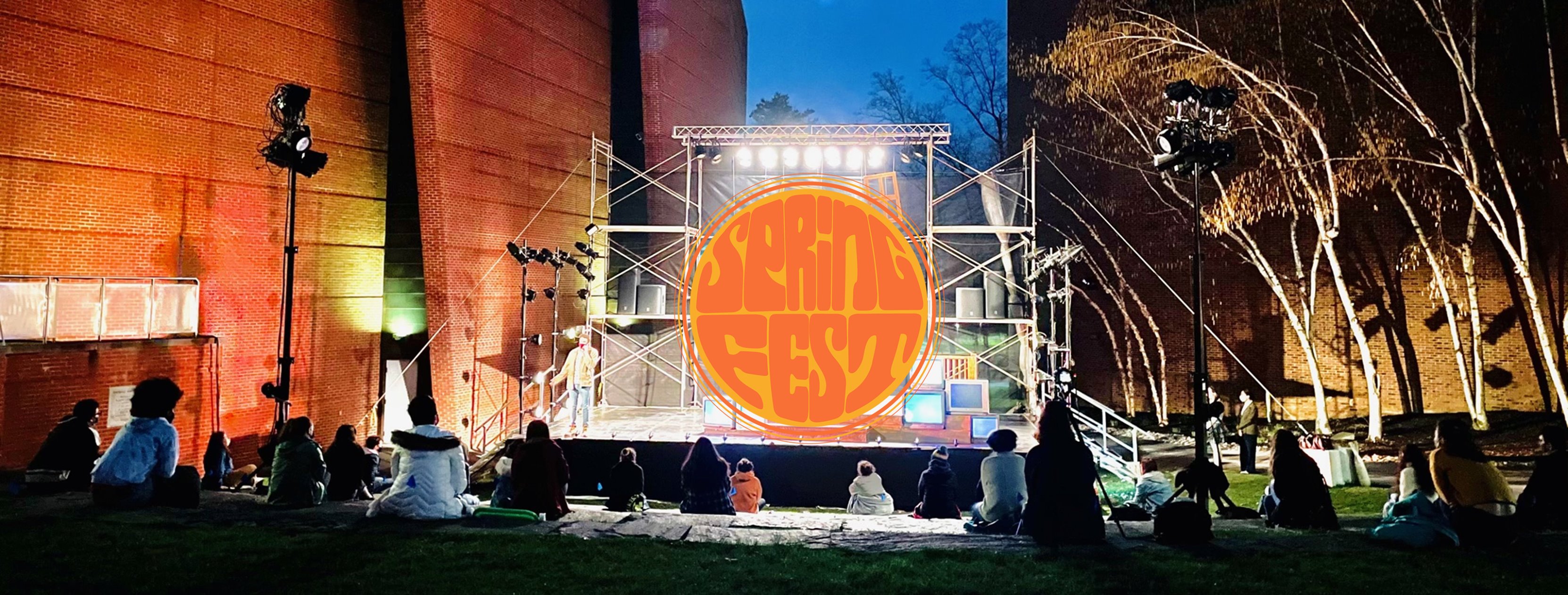Co-Edited by Eliza Kuperschmid ‘21 and Gemma Siegler ‘22
We made it! The third weekend of SpringFest marks the conclusion of this massive department-wide effort. Nearly 150 students and staff members were part of making this festival possible. As we’ve said in the last two pieces, SpringFest had no shortage of drama, and Weekend Three was no exception. Despite pouring rain, virtual performances, and the always-present challenges of the Pandemic, the Weekend Three productions wrapped up the entire festival in the best way.
With fifteen different performances happening throughout SpringFest, STLN thought that the best mode of reporting would be “Weekend Wrap-Ups,” one article per weekend containing everything you need to know about what happened on the SpringFest stages. Hopefully, the joy of the SpringFest audience members can be felt through our staff writers’ brief summaries of each weekend two performance below!
___
No Names
Covered by Maggie McGuire ’24
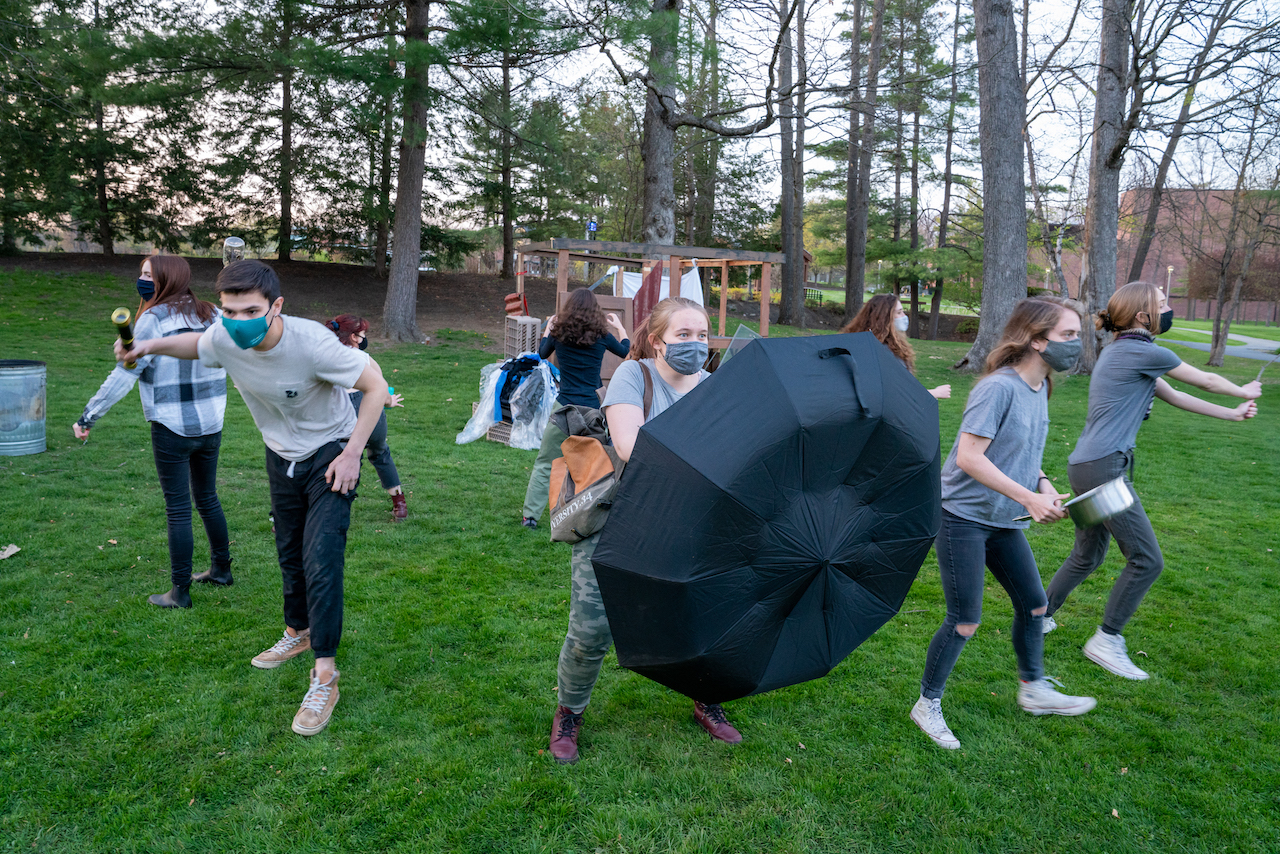
Photo by Coltrane Cho ’24
No Names, a devised piece directed by Fabian Rodriguez ’22, is a short look into a future that’s not too far from becoming our reality. Inspired by A Children’s Bible by Lydia Millet, the play follows a society of teenagers trying to survive the aftermath of a climate apocalypse. Among them there are hunters, scavengers, a devote Christian, peacekeepers, thieves, and an imposter — an alien that uses pollution to feed off of everyone else’s energy. Everyone has a job, everyone follows the rules, and everyone is silent… until they aren’t.
Being a part of this show was a huge learning experience for me. Before No Names, I had never worked on a devised piece, nor did I ever consider the various ways in which theater can be created. The biggest challenge our team faced was how we were going to put on a show that warned people about the dangers of climate change in only ten minutes and without using any dialogue. We wanted to somehow immerse our audience into the world of the apocalypse, rather than having them observe from afar. The creative process of making No Names began with many conversations about what is happening in the world today. In 2020 and 2021 alone, our world has witnessed wildfires, melting icecaps, hurricanes and typhoons, and the hottest summer on record. A major point Fabian made during rehearsals was that in the world of No Names, the aliens that feed on human energy did not bring about the apocalypse. Rather, humans were the cause of their own downfall, allowing for these disguised invaders to take over without anyone noticing.
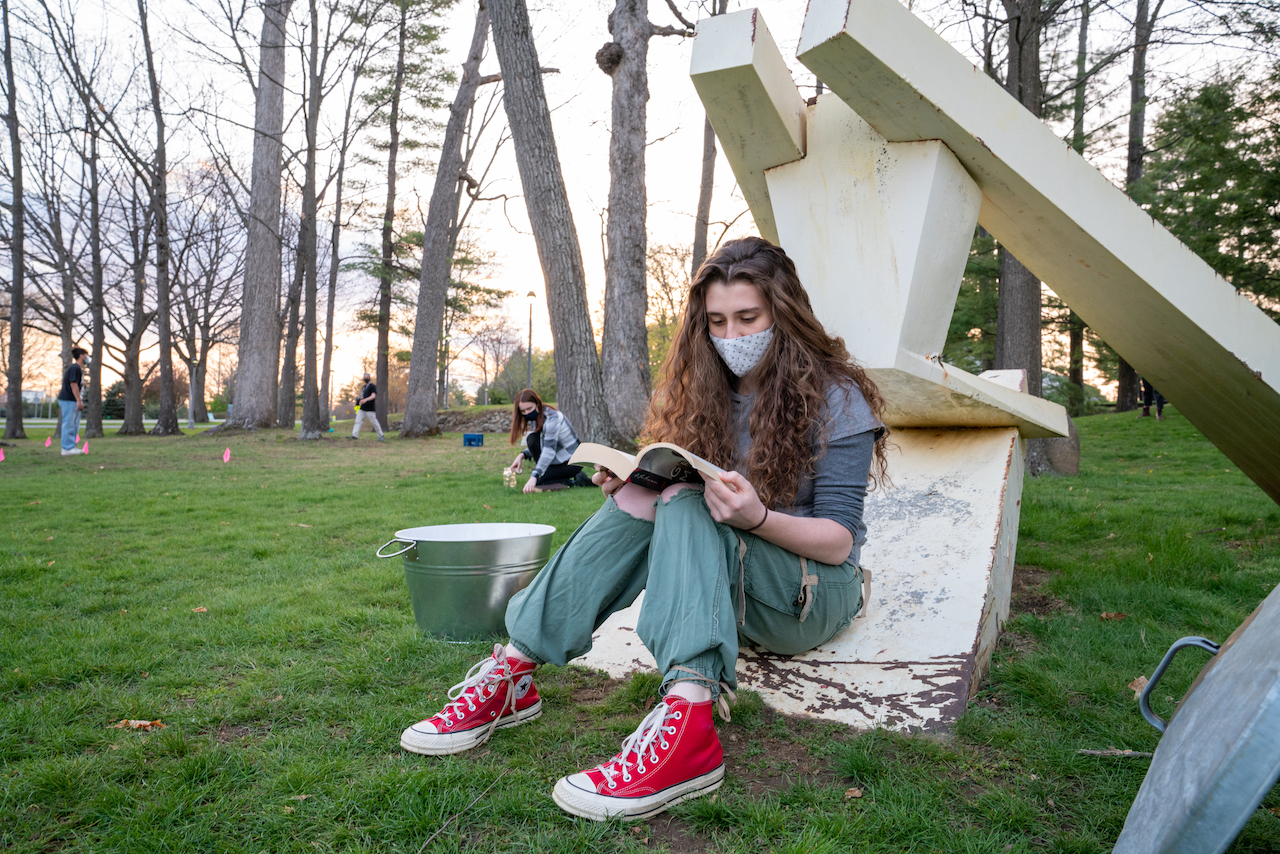
Photo by Coltrane Cho ’24
From there, the cast was able to create our own characters by determining what they witnessed in the midst of the apocalypse. For example, my character was separated from her family in some sort of catastrophic event (such as a wildfire) and the only thing she had left was a rattle that belonged to her younger sibling. I used the rattle as a means of getting peoples’ attention, as well as stress toy for anxious tics, a result of my character’s PTSD. Meanwhile, Emma Mangol’s (’24) character was extremely religious; she believed that the apocalypse was the rapture. Her character believed in preaching good morals to the rest of the group, otherwise she feared we’d all be caught by the devil. Her story in the opening scene foreshadows everything that happens throughout the play.
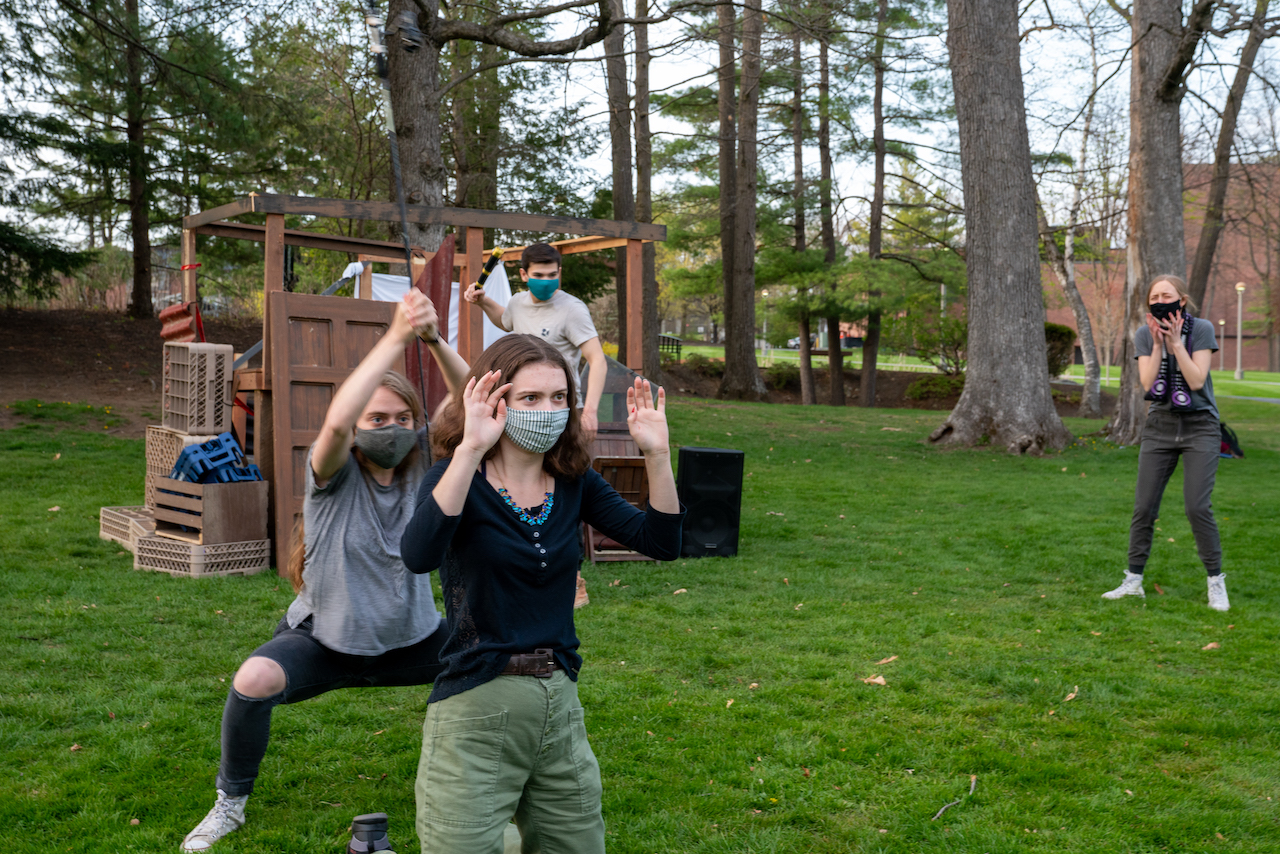
Photo by Coltrane Cho ’24
Callan Daniel’s (’23) character was traveling with her father when the world ended. The only thing she had left of him was a knife. Callan’s character was the strongest of the group, therefore making her the perfect hunter and patrol guard, unafraid to kill even her own group members if she had to. Everyone’s backstory influenced the decisions made in the world of No Names, but Marin Asnes’s (’21) character backstory was the most interesting. As the oldest and wisest of the group, Marin’s character assumed the role of leader. However, because of her ability to gain everyone’s trust, no one questioned her obsession with collecting precious metals to re-build a large structure of sorts. In their own paranoia, the entire group turns on Leah Cunningham’s (’23) character and no one ever suspects that Marin was the imposter all along.

Photo by Coltrane Cho ’24
The job of the cast was to tell this story using only movement. However, the world of No Names really came to life through the hard work of the entire production team: Amelia Schuster ’21 (scenic design), Jade Kobor ’24 (costume design), Madeline Munding ’22 (sound design), and Liz Cohen ’23 (stage manager). Through the use of different props and sounds, we were able to create an apocalyptic, dying world all on a beautiful Skidmore spring day. The cast wore all gray and black and we covered our bodies in dirt. As the characters were supposed to be living among garbage, we scattered crates, boxes, and various other items throughout the woods down by the pond to create a campsite. The focal point of our set was a large platform built entirely out of garbage. Finally, to enforce the idea that the world of No Names was not too far off from the world humans are on the path to creating, our audience experienced the show by walking throughout the campsite themselves and standing around the set.
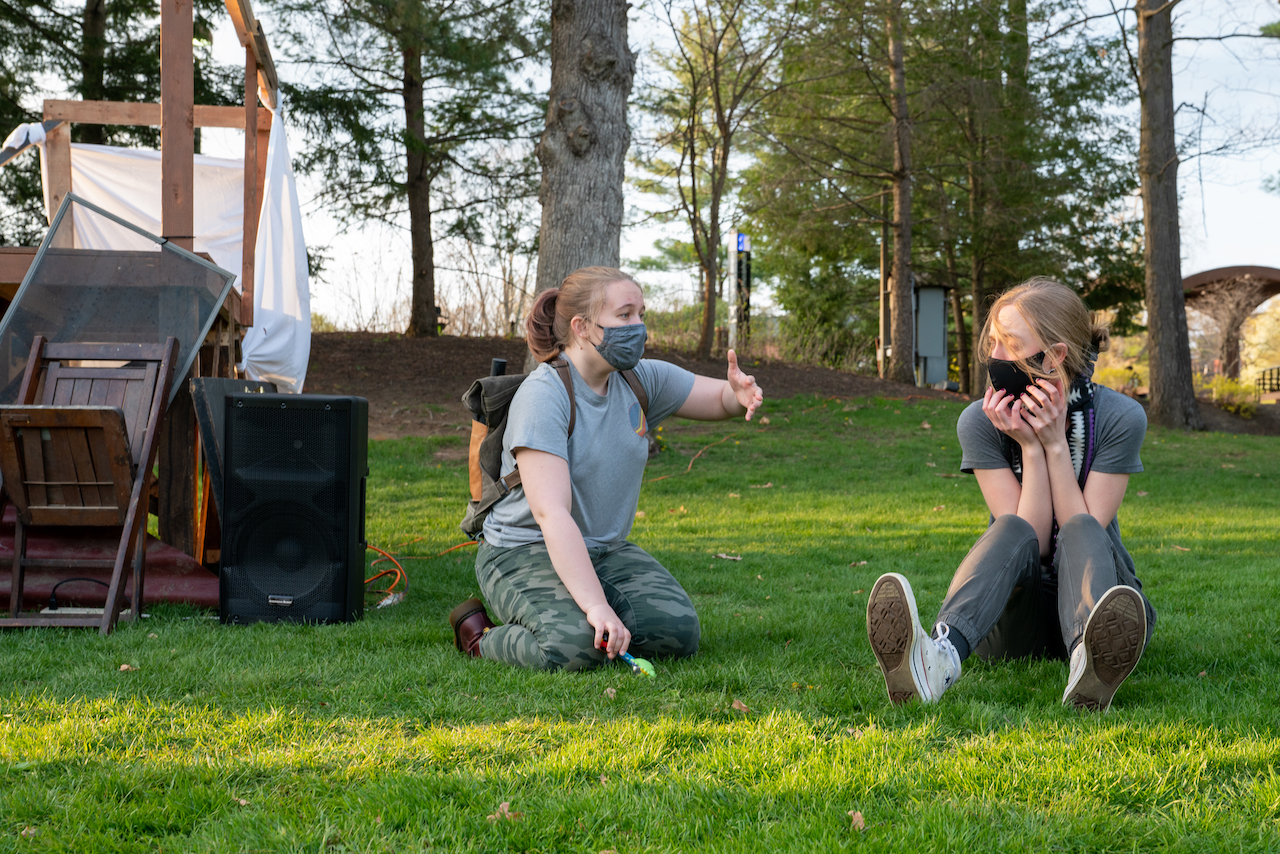
Photo by Coltrane Cho ’24
No Names is a cautionary tale, reminiscent of Lord of the Flies or Annihilation, that discusses the dangers of climate change and a crumbling society. Everyone on the No Names team connected really well and were able to create this show together as one devising team. I want to thank director Fabian Rodriguez for showcasing this piece during a crucial time for our environment. The message of No Names is that if we don’t act today, we won’t have a world tomorrow.
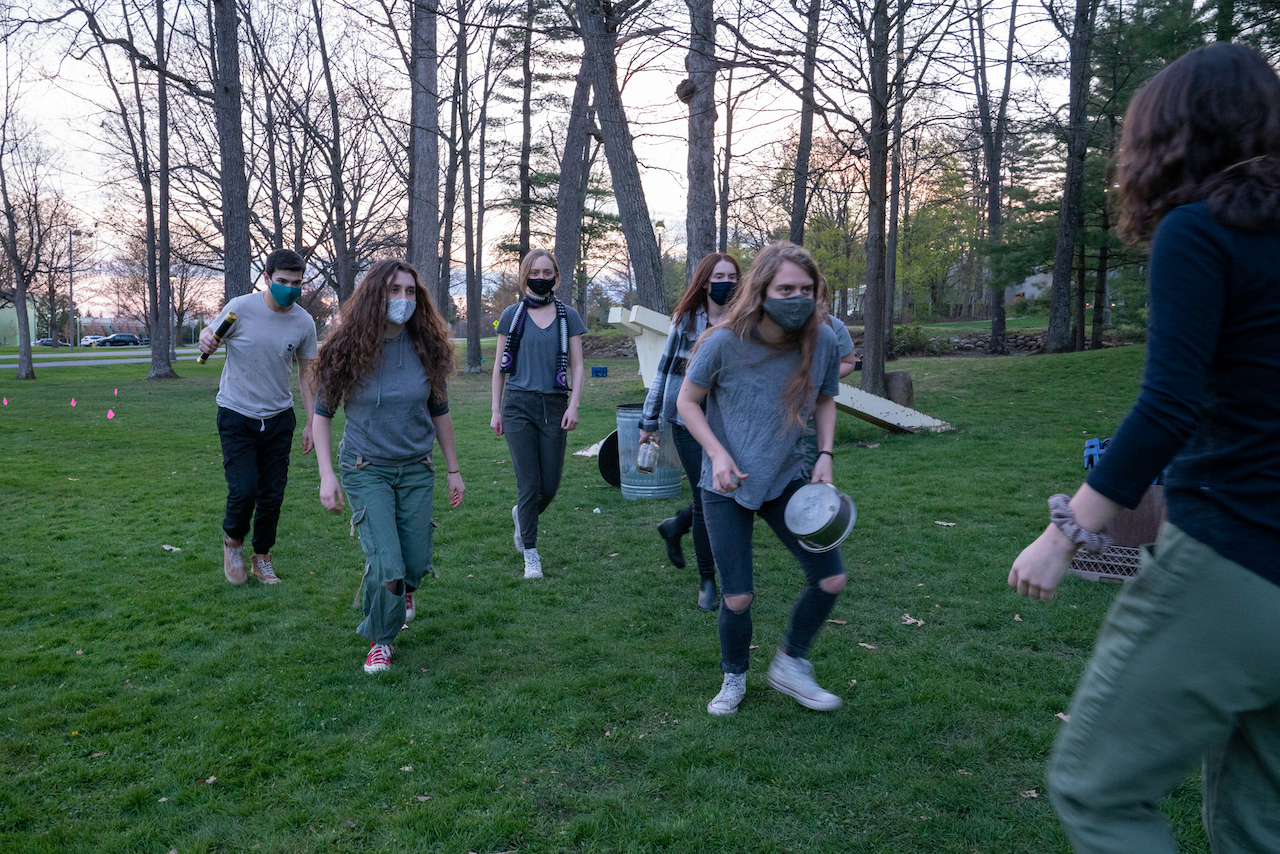
Photo by Coltrane Cho ’24
LEAD ARTIST AND DIRECTOR: Fabian Rodriguez ’22
STAGE MANAGER: Liz Cohen ’23
SCENIC DESIGN: Amelia Schuster ’21
PROPS MASTER: Liz Cohen ’23
SOUND DESIGN: Madeline Munding ’22
COSTUME DESIGN: Jade Kobor ’24
CAST: Marin Asnes ’21, Leandro Bustos ’23, Leah Cunningham ’23, Callan Daniel ’23, Emma Mangol ’24, Maggie McGuire ’24, Ida Mihok ’24, Dani Wood ’24
___
Frozen Fluid
Covered by Gemma Siegler ’22

Photo by Wynn Lee ’21
Frozen Fluid, directed by Eliza Martin ‘21, was both a powerful and thrilling example of a fantastical play that deals with very realistic, modern day issues. I think that the subtitle of the play, “An Antarctic Gender Non-Conforming Creation Myth,” encapsulates what this play aims to do: create an access point for queer people into a very heterosexually dominated form of storytelling, such as the creation myth.
Walking into the Amphitheater as an audience member, I was immediately visually transported into the world of the play. This was in large part because of the beautiful set, designed by Sully Sullivan ‘22 and complimentary lights, designed by Patrick Carter ‘22. The audience was also greeted by cast member Lily Kops ‘22 (“Terra”) laying in what appeared to be some sort of coffin illuminated by bars of light. Cast members Lucrezia Zichichi ‘24 (“Tay”) and Will Davis-Kay ‘23 (“Herman”) were also roaming about the stage conducting some sort of scientific research.
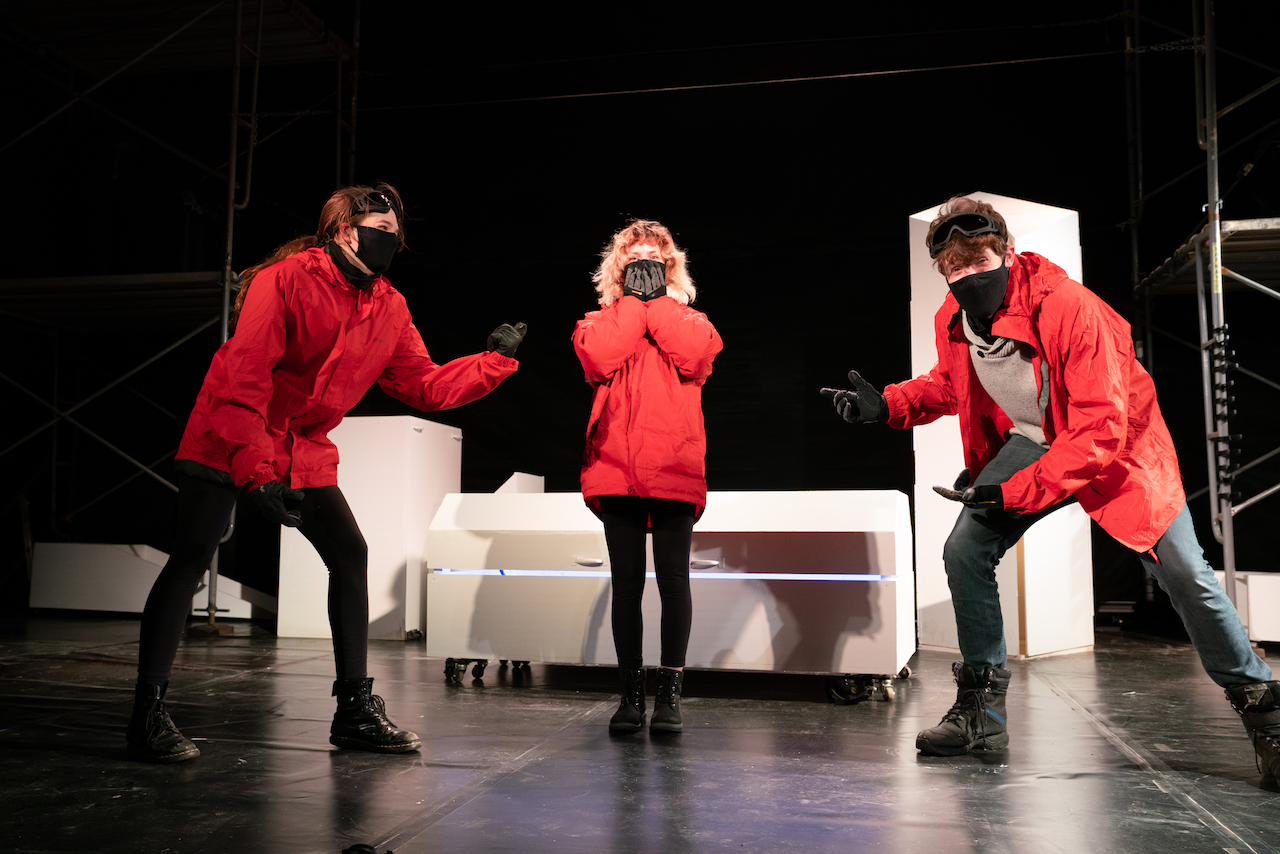
Photo by Wynn Lee ’21
Throughout the play, each of these characters revealed parts of themselves that challenged the audience’s expectations of gender, science, and relationships. I am thinking specifically about the moment when Herman revealed his real name. This was a way to explain to the audience the ways in which names are a social construct. Also, the moment when Terra finds out about Herman’s real name and freaks out, serving as a parallel for how Terra reacts when she finds out Tay’s pronouns. These moments, and many more, helped the audience to understand this play as both its own entity and as a tool through which the playwright, Fly Jamerson, wants to help audiences to understand the potential challenges of identifying as non-binary or trans.

Photo by Wynn Lee ’21
At the particular showing of Frozen Fluid that I went to, it was pouring rain the entire performance. This actually enhanced a lot of the play’s meaning. Not only did the natural element of rain highlight the environmental messages of the play, but it also demonstrated to me, as an audience member, how committed everyone in the cast and crew was to making this production work. Even in the moment when the actors had to break out of the pacing of the play to move set pieces carefully, everyone remained in character and present. While I’m sure this was not the ideal environment the team imagined for the piece, I’m actually glad I got to see it with the rain. It made the entire piece feel so connected to nature.
Frozen Fluid was a major success on the part of everyone involved. I know this to be true by the fact that everyone in the audience stayed to watch the entire show, even during a rainstorm.
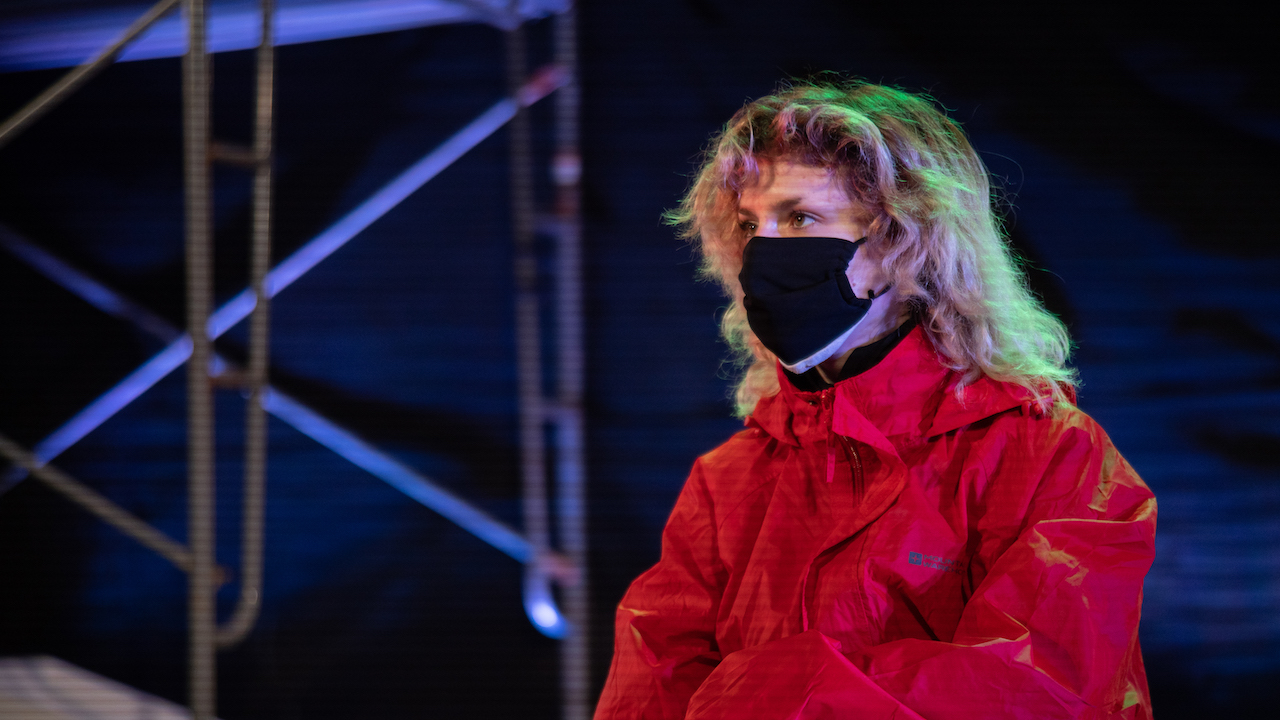
Photo by Coltrane Cho ’24
LEAD ARTIST AND DIRECTOR: Eliza Martin ’21
DRAMATURG: Cas Clifford ’21
STAGE MANAGER: Patrick Carter ’22
SCENIC DESIGN: Sully Sullivan ’22
PROPS MASTER: Sully Sullivan ’22
LIGHTING DESIGN: Patrick Carter ’22
SOUND DESIGN: Cas Clifford ’21
COSTUME DESIGN: Lucy Holden ’22
CAST: Will Davis-Kay ’23, Lily Kops ’22, Lucrezia Zichichi ’24
___
Living Through Isolation
Covered by Emily Zeller ’22
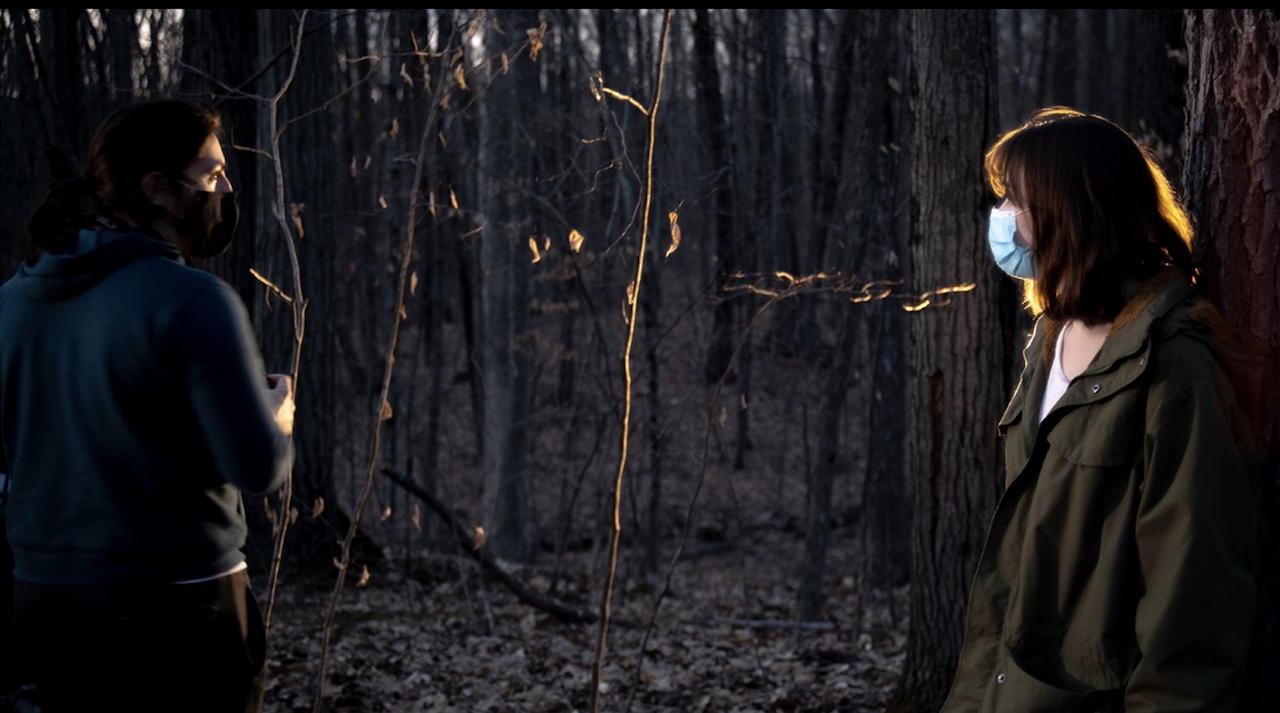
Screenshot courtesy of Sue Kessler
May 1st and 2nd at 10:00 pm and 11:00 pm, Living Through Isolation, directed by Anthony Nikitopoulos ’21 was screened at the loading dock of the JKB. The piece was a devised work, created as a collaboration between Nikitopoulos, Penelope Constantino ‘24, Noah Greenfield ‘24, and Penn Hoen ’24 and it centered around the struggles and limitations of the COVID-19 pandemic.
The show included images, audio, and videos of current events surrounding the pandemic. Each member of the cast recited poetic representations of their inner thoughts as they entered these unprecedented times. Bonds were formed between cast members as they met masked and in person. These scenes were accompanied by sharp jump cuts and transitions that left the cast members alone and in isolation from the outside world. The comfort of being alone was also discussed in the piece, as opposed to just the loneliness aspect.
What does it mean to value alone time? When will we have to push ourselves back into the real world? We were brought into the personal spaces of the actors and got to see how they navigate their confined, pandemic worlds. Imagery of nature was also used in the piece to show that despite our challenges, the world keeps turning and it is our job to keep pushing through as well. As we all sat masked in the audience, I wondered about the future of theater. Because we are allowed to gather in some capacity right now, my hopes and energy for the future were sparked.
Living Through Isolation culminated by pointing out how even though there have been extreme senses of struggle and loss during this past year, a sense of hope and opportunity is on the horizon. Nikitopoulos and his cast were able to evoke the experience felt by millions around the globe this year to show how we are all truly in this together.
LEAD ARTIST AND DIRECTOR: Anthony Nikitopoulos ’21
STAGE MANAGER: Lindsey Shafer ’23
SCENIC DESIGN: Isaac DeMarchi ’23
LIGHTING DESIGN: Isaac DeMarchi ’23
SOUND DESIGN: Grace Palmer ’22
COSTUME DESIGN: Maggie McGuire ’24
CAST: Penelope Constantino ’24, Noah Greenfield ’24, Penn Hoen ’24
___
Optais Amme
Covered by Madeline Munding ’22
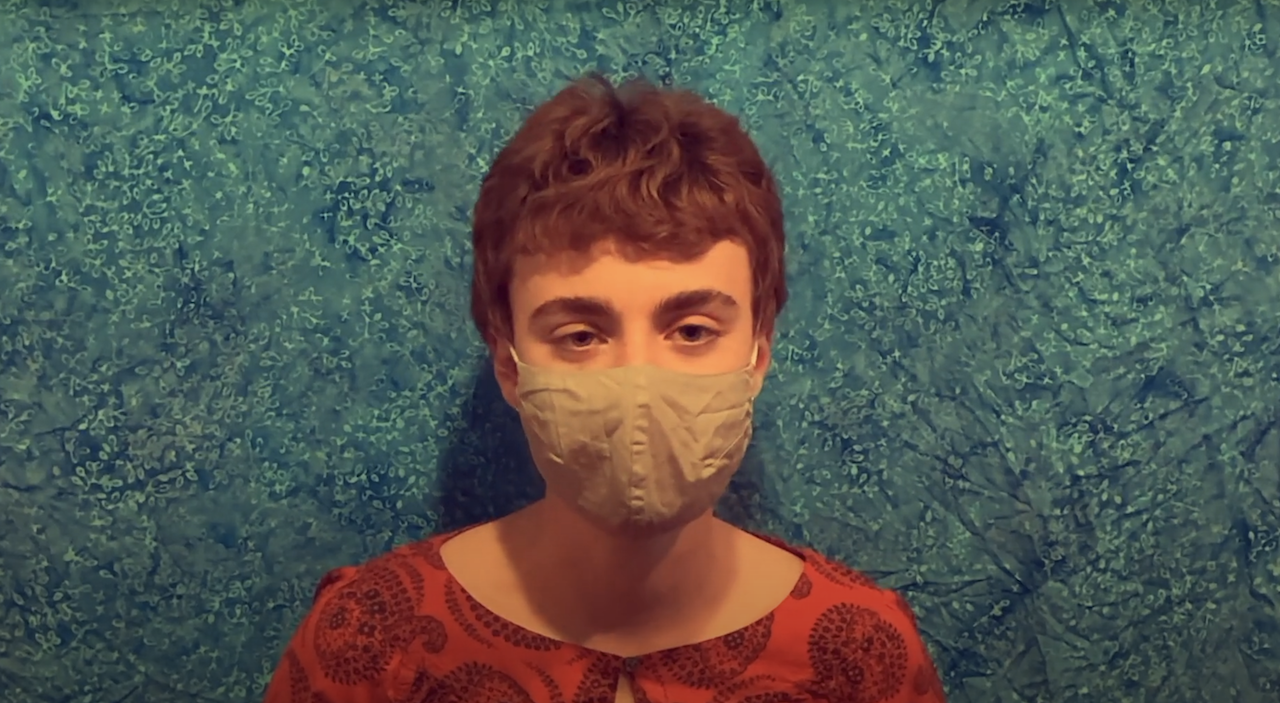
Screenshot courtesy of Eliza Kuperschmid ’21
Optais Amme was written and directed by Cate Jul LeCours ‘22. It is the last play in LeCours’s cycle, Tales from the Other Country, a collection of plays that explore gender, hierarchy, violence, free will, and jealousy. This piece starred Sariah Johnson ‘24 as “Diana,” Joe Newman-Getzler ‘21 as “Lew,” and Emma Powell ‘23 as “Oliver.” The piece was filmed in LeCours’s now signature style: elements of stop-motion, hand-made drawings and knitting, colorful silks, and antique-looking objects.
The faraway Other Country is ruled by a tyrannical Princess. In this realm, the peasants are split into two sections — the boys who do the outdoor, intensive manual labor and the girls who do domestic labor indoors. There is a child named Oliver who is envious of the Princess for her beauty. In return, the Princess is jealous of Oliver’s child-like freedom. Oliver struggles with their identity; they do the boys’ work yet want to be able to do the girls’. As a result of their jealousy, Oliver creates the Fire Tide, which at first was meant to go against the class and gender divides in the Other Country. The plan backfires when other boys join the Fire Tide and their misogyny and lust for power corrupts Oliver’s original vision. They begin burning all of the girls in the country.
Diana, a soothsayer and independent girl, sits preparing her trousseau for her wedding while waiting for Oliver. When Oliver arrives, Diana questions Oliver’s motives but knows that they will eventually end up setting her on fire no matter what. She also knows that this death will change Oliver. Optais Amme wrestles with gender identity and classism, presenting it in a mix of old language and new. Despite the mysticism and fairytale-ness of LeCours’ piece, it very much speaks to the current moment.
You can view Optais Amme here.
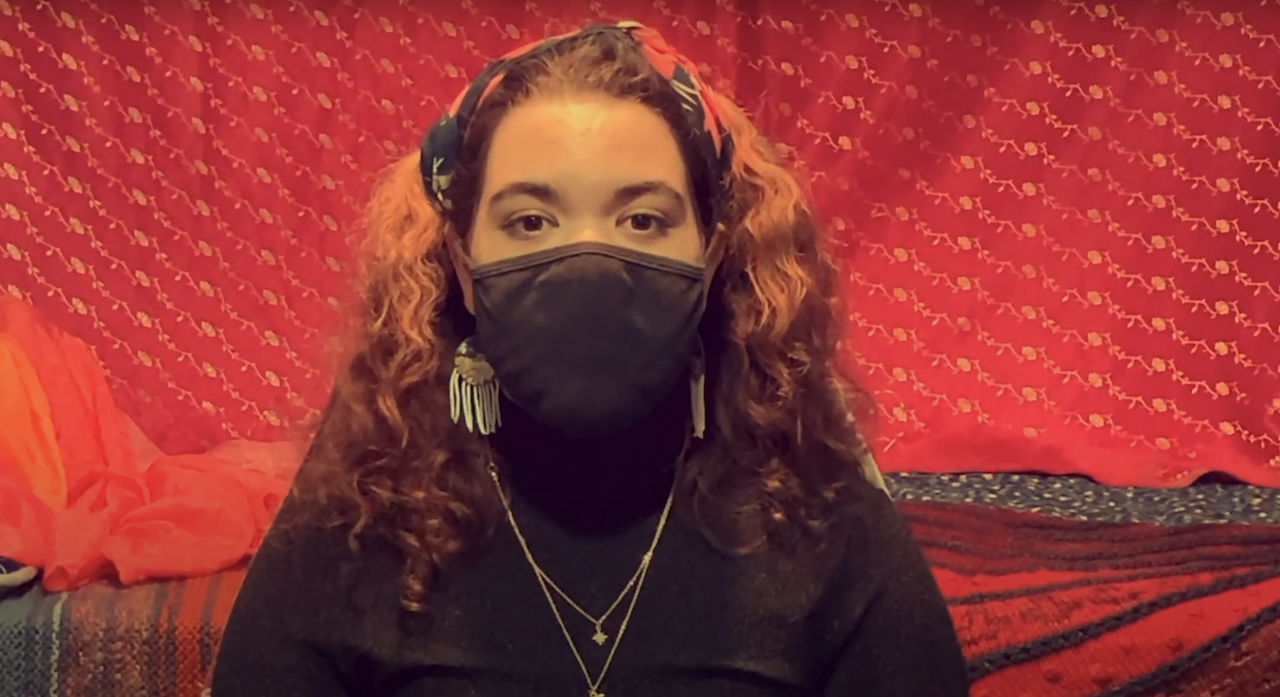
Screenshot courtesy of Eliza Kuperschmid ’21
LEAD ARTIST, PLAYWRIGHT, AND DIRECTOR: Cate [Jul] LeCours ’22
STAGE MANAGER: Claire Fink ’22
SCENIC DESIGN: Cameron Jabs ’21
PROPS MASTER: Cameron Jabs ’21
CAST: Sariah Johnson ’24, Joe Newman-Getzler ’21, Emma Powell ’23
___
L0S3RS: The Video Game Play
Covered by Emily Zeller ’22

Screenshot courtesy of Sue Kessler
Streaming online May 2nd at 6:30 pm, L0s3rs: The Video Game Play, written, directed, and edited by Lily Kops ‘22 premiered as a virtual experience. The play chronicled the lives of four middle school boys as they navigate friendships and growing up with a shared pastime: gaming. Jack, played by Carter Jones ‘22, is joined online by his friends Kyle (Julian Tushabe ‘22), Timmy (PJ Moller ‘24), and Johnny (Mary MacKeen ‘23) as they chat and play video games on a streaming server reminiscent of Discord.
As we watch the play unfold, the boys battle their own personal conflicts at home, Johnny in particular. Tension rises as a sensitive young Timmy becomes a bother to those in the group and is consistently bullied by them. Every time Timmy joins the call, the boys find themselves irritated and fed up with his timid behavior. That is until “K1LLSW1TCH” (played by Sully Sullivan ‘22) joins the call. The boys, like most middle schoolers, are shocked and somewhat rattled by the presence of a girl in their space.
Jack struggles to form a bond with his younger sister Erin (played by Kathryn Stathakis ‘22), who also finds herself interested in the antics of the boys. K1LLSW1TCH begins her tirade on the boys by calling them weak and incapable. She points out their inability to let people into their gaming group who are not exactly like them, which serves as a threat to their character. The boys soon find a way to stand up to K1LLSW1TCH and conclude the play by kicking her out of their server.
Although the boys were able to stand up to K1LLSW1TCH and ultimately get rid of her, to me as an audience member, K1LLSW1TCH had a greater impact on the boys then they thought. Her ability to pinpoint the exclusive behavior of the boys allowed them to look in on themselves and right their wrongs. Not only were they able to protect Timmy, who was a main target of K1LLSW1TCH’s bullying, but Jack was able to strengthen personal life as he bonded with his sister and encouraged her to continue her video game journey, even when he’s not around.
L0s3rs was a fantastic representation of the rollercoaster that is growing up. Often where we turn to find escape in life’s most confusing moments is sometimes where we learn the most. Through humor, honesty, and good old fashion fun, Kops was able to bring that to life on the screen for audience members.
LEAD ARTIST, PLAYWRIGHT, AND DIRECTOR: Lily Kops ’22
STAGE MANAGER: Henry Tate ’23
SCENIC DESIGN: Kinzie Lane ’21
PROPS MASTER: Kinzie Lane ’21
LIGHTING DESIGN: Henry Tate ’23
SOUND DESIGN: Ryan Gomez ’24
COSTUME DESIGN: Parker Nelson ’23
VIDEO DESIGNERS: Emma Eisner ’22 and Sophia Ward ’22
COMPOSER: August Sylvester ’20
CAST: Carter Jones ’22, Mary MacKeen ’23, PJ Moller ’24, Kathryn Stathakis ’22, Sully Sullivan ’22, Julian Tushabe ’22
***
Eliza Kuperschmid ’21 and Gemma Siegler ’22 are Co-Editors-in-Chief of the Skidmore Theater Living Newsletter

